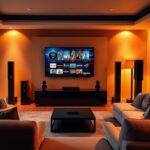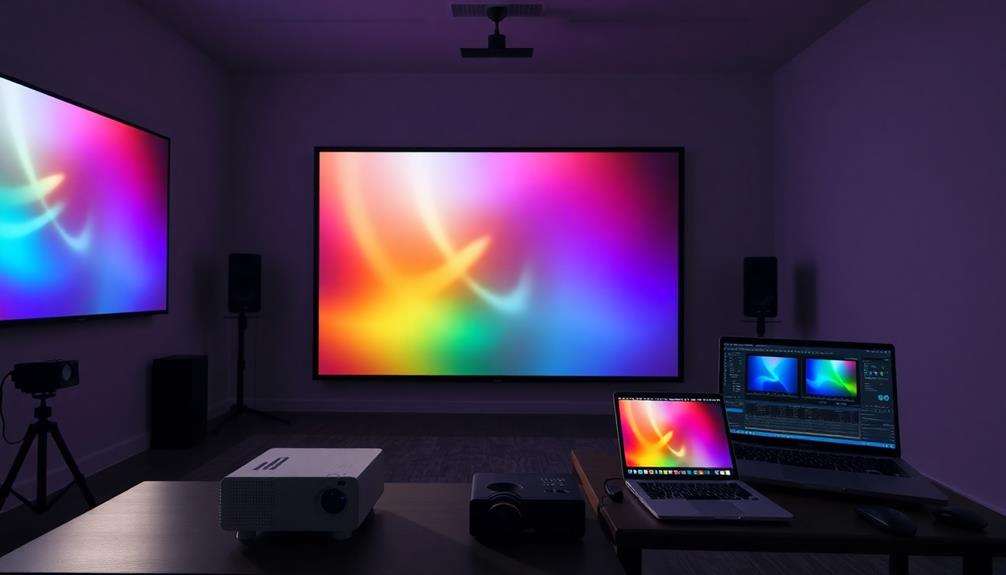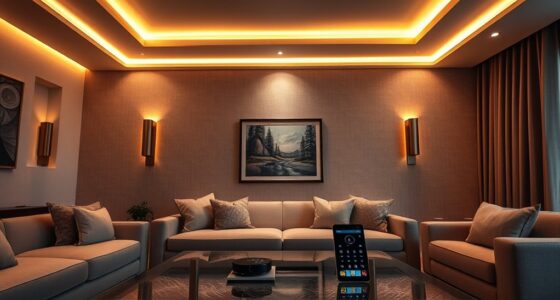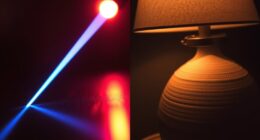Shifting from cable to streaming is easier than you might think. Start by evaluating your viewing habits and budget. You'll find plenty of streaming services to accommodate your favorite shows, such as Sling TV and YouTube TV. Consider using an over-the-air antenna to access local channels for free. Remember to check if your TV has HDMI ports for streaming devices like Roku. You'll need a stable internet connection with at least 25 Mbps to keep things running smoothly. If you explore further, you'll uncover more tips and options to make your switch seamless and enjoyable.
Key Takeaways
- Assess your content needs and budget to choose the right streaming services and avoid high subscription costs.
- Use an over-the-air antenna to access local channels in Full HD without monthly fees.
- Select streaming services like Sling TV or YouTube TV for live content and customize your channel lineup.
- Ensure your TV has an HDMI port and a reliable WiFi connection with at least 25 Mbps for smooth streaming.
- Take advantage of free streaming services like Pluto TV and Tubi for additional content without subscription costs.
Getting Started With Cord-Cutting
Getting started with cord-cutting can feel overwhelming, but it doesn't have to be. With over 80% of TVs in households being internet-enabled Smart TVs, you're already equipped to shift to streaming without needing additional devices.
First, assess your content needs and budget. You might be surprised to find that the cost of multiple streaming subscriptions can rival traditional cable bills.
A great way to save is by using an external antenna, which ranges from $20 to $150. This allows you to access local channels without ongoing subscription fees, providing significant savings.
Major metropolitan areas typically offer a wider variety of free TV options, making it easier for you to find your desired local channels.
Once you've set up your antenna, use your TV's Scan function to locate available broadcast channels. This step is essential for ensuring you get the most out of your cord-cutting experience.
By combining streaming services with an antenna, you can enjoy a robust viewing experience without the hefty price tag of cable.
Choosing Streaming Services
Now that you've set up your antenna and identified your local channels, it's time to explore your streaming options. As you navigate this shift, consider how the global political climate may influence media coverage and streaming availability in your region.
When choosing streaming services, start by making a list of the shows and channels you regularly watch. This will help you pinpoint which services meet your content needs, as no single service can match the extensive variety offered by cable.
For live TV, services like Sling TV and YouTube TV deliver real-time channels over the internet, with prices starting at $40 and $73 per month, respectively.
If you're interested in streaming content, popular platforms like Netflix and Hulu offer vast libraries, with Netflix plans ranging from $6.99 to $22.99, and Hulu with Live TV starting at $76.
As you assess subscription costs, keep in mind that bundling options are emerging, such as the anticipated Disney Plus, Max, and Hulu bundle in summer 2024. This could enhance value if you're looking for multiple services.
However, be careful—if you don't select wisely based on your preferences, your total subscription costs could rival your old cable bill.
Live TV Streaming Options
When it comes to live TV streaming options, you've got several popular services to choose from, like YouTube TV and Sling TV. Each offers different subscription pricing models, making it easier to find one that fits your budget.
For those who appreciate the cinematic experience at home, investing in a quality projector can elevate your viewing sessions, especially when paired with top gaming projectors that provide high refresh rates and low input lag.
Plus, if you're a sports fan, you'll love the variety of channels available through services like Fubo TV.
Popular Live Streaming Services
Live TV streaming services have quickly become a popular alternative to traditional cable, offering flexibility and a range of channel options to suit different preferences. Among the top choices, Sling TV starts at $40/month, providing customizable channel lineups.
YouTube TV, priced at $73/month, stands out with its unlimited cloud DVR storage, allowing you to record your favorite shows effortlessly. If you're a sports fan, Fubo TV is your best bet, starting at $80/month and featuring extensive live sports coverage.
Hulu with Live TV, at $76/month, combines popular streaming channels with live TV, making it a versatile option for many viewers. These live TV streaming services mimic cable offerings but give you the freedom to add or cancel channels without long-term contracts.
Plus, bundling options are on the rise, with services like Disney Plus planning combined offerings in summer 2024, which could save you money while expanding your viewing options.
Whether you prioritize live sports, entertainment, or a mix of both, there's a streaming service out there that fits your needs perfectly.
Subscription Pricing Models
Subscription pricing models for live TV streaming services offer an invigorating alternative to traditional cable, allowing you to pay only for the channels you want. Sling TV starts at just $40/month, while YouTube TV is priced at $73/month.
If you're interested in a broader content library, Hulu + Live TV costs $76/month and includes access to live channels and Hulu Originals. For sports fans, Fubo TV is tailored for you, starting at $80/month, with features for streaming and recording live sports.
As you explore these streaming services, keep in mind that subscription costs can add up. While some services appear budget-friendly, the combined cost of multiple subscriptions may rival traditional cable bills.
It's crucial to assess your viewing habits and prioritize channels that matter most to you. Additionally, bundling options are on the rise, like the Disney Plus, Max, and Hulu bundle set to launch in summer 2024, which could provide added savings.
Sports Streaming Availability
As you consider your options for streaming services, it's essential to recognize the growing availability of live sports coverage. Many popular sports streaming services now offer extensive live sports options, allowing you to enjoy your favorite events without cable.
For instance, YouTube TV, priced at $73/month, provides unlimited cloud DVR storage, letting you record live sports events to watch later. Additionally, it's important to be aware of potential tax implications when managing your retirement funds, especially if you plan to use those funds for leisure activities such as sports streaming in retirement tax implications of inherited IRAs.
Fubo TV, starting at $75/month, is specifically designed for sports enthusiasts, giving you access to a wide range of live sports coverage. If you're a football fan, keep in mind that NFL games are primarily broadcast on CBS, Fox, and NBC. You may need an antenna for local channels or a streaming service to catch these games live.
In addition to these services, ESPN+ ($11/month) and MLB.TV ($25 for live or on-demand games) offer more niche sports content, though they may have blackout restrictions.
Free and Niche Streaming Services
If you're looking to save money while enjoying a variety of content, free and niche streaming services might be the perfect solution. These platforms provide extensive libraries and cater to specific interests, offering alternatives to traditional cable.
Here's a snapshot of some popular options:
| Service | Type | Cost |
|---|---|---|
| Pluto TV | Free Streaming | Free with ads |
| Tubi | Free Streaming | Free with ads |
| CrunchyRoll | Anime | Subscription: $7.99 – $14.99 |
| Shudder | Horror | Subscription: $5.99/month |
| Mubi | Independent Films | Subscription: $14.99/month |
| Acorn TV | British TV | Subscription: $6.99/month |
| Viki | Asian Dramas | Subscription: $5.99/month |
With free streaming services like Pluto TV and Tubi featuring vast libraries—over 100 live channels for Pluto and more than 60,000 titles for Tubi—you can explore without spending a dime. If niche content appeals to you, platforms like CrunchyRoll, Shudder, and Acorn TV provide unique options, some even offering ad-free subscriptions.
Enhancing Your Viewing Experience
To enhance your viewing experience, consider utilizing cloud DVR options that let you record your favorite shows, like the unlimited storage offered by YouTube TV.
You can also take advantage of an over-the-air antenna to access local channels in Full HD without any subscription fees.
Together, these tools can transform how you enjoy content, giving you more control and flexibility.
Cloud DVR Options
Cloud DVR options can greatly enhance your viewing experience by allowing you to record live shows and watch them at your convenience. Live TV streaming services like YouTube TV and Hulu + Live TV provide robust cloud DVR capabilities. YouTube TV even offers unlimited DVR storage for up to nine months. On the other hand, Sling TV provides a cloud DVR option with 50 hours of recording space, which you can upgrade to 200 hours for an extra fee.
It's important to note that some services impose limitations on recording due to licensing agreements, so double-check policies before subscribing. One of the most useful features of cloud DVR is the ability to pause and rewind live TV, ensuring you never miss a moment. However, keep in mind that internet speed is critical; a minimum of 25 Mbps is recommended for smooth recording and playback of multiple shows.
| Service | Cloud DVR Features |
|---|---|
| YouTube TV | Unlimited storage, 9-month access |
| Hulu + Live TV | Limited storage, varies by plan |
| Sling TV | 50 hours (upgrade to 200 hours available) |
| DVR Restrictions | Some shows may not be recordable |
| Internet Speed | Minimum 25 Mbps recommended |
Over-the-Air Antenna Benefits
Many viewers are discovering the advantages of over-the-air antennas as a way to enhance their television experience.
These devices allow you to access major local broadcast networks like FOX, ABC, NBC, CBS, and PBS in Full HD without any subscription fees. By opting for over-the-air antennas, you can save considerably on recurring cable costs, as it's a one-time purchase that eliminates monthly cable fees.
Most cable subscribers watch only about 17 channels, many of which you can receive for free with an antenna. Depending on your geographical location, antennas can provide a range of channel availability from 20 to over 100 miles, with premium models offering enhanced reception.
Installation is straightforward; most TVs come with a built-in feature to scan for local broadcast channels, making it easy for you to access programming.
Once you've set up your antenna, you'll enjoy the freedom of watching your favorite shows without the burden of ongoing costs.
Transitioning to Streaming
Shifting to streaming can feel overwhelming, but with the right approach, it's a manageable alteration that opens up a world of viewing options.
To successfully adapt, consider these key steps:
- Assess your viewing habits: Identify the shows and channels you watch regularly.
- Choose the right streaming services: Look into options like Sling TV or YouTube TV for live channels that mimic your former cable service.
- Invest in a streaming device: Make sure your TV has an HDMI port for devices like Roku or Amazon Fire Stick.
Ensure you have a reliable WiFi network with a minimum speed of 25 Mbps to avoid buffering during your favorite shows.
You might also consider a one-time purchase of a TV antenna to access local TV stations like ABC, NBC, and CBS without ongoing fees, helping you cut the cable cord efficiently.
The flexibility of streaming services allows you to subscribe or cancel based on your preferences without the long-term contracts that come with cable service.
Embrace this new era of entertainment, and enjoy tailored viewing experiences that fit your lifestyle!
Frequently Asked Questions
What Do I Need to Switch From Cable to Streaming?
To switch from cable to streaming, you'll need a reliable internet connection, a smart TV or streaming device, and possibly an antenna for free channels. Make a list of your favorite shows to choose the right services.
How to Get Rid of Cable and Just Stream?
You think cutting the cord means losing your favorite shows? Ironically, it opens a world of streaming options. Start by listing must-watch channels, getting an antenna, and exploring reliable streaming services. You'll thrive!
Is It Worth Switching From Cable to Streaming?
Switching from cable to streaming's definitely worth it! You'll save money, enjoy flexible subscriptions, and access a wider variety of content. Plus, with free trials, you can explore options risk-free before committing.
How Do I Cancel Cable but Keep Internet?
You won't believe how easy it is to cancel cable and keep your internet! Just contact your provider, switch to an internet-only plan, and enjoy those savings while streaming your favorite shows hassle-free.
Conclusion
As you embrace the cord-cutting lifestyle, remember that you're not alone—over 50 million U.S. households have made the switch to streaming. This change opens up a world of content tailored just for you, without the hefty cable bills. By exploring various services and optimizing your setup, you'll enjoy a more personalized viewing experience. So, immerse yourself, explore your options, and discover how streaming can transform your entertainment routine!















